Baljuri 5922m: An Alpine Style Attempt in winter - Expedition report
Anindya MukherjeePhotographs: Anindya Mukherjee
Category: Expedition, Climbing
Date of Publication: Feb 14 , 2021
Summary
A team of 4 climbers (Aniket Mitra, Rivusoumya Das, Ashish Chanda and Anindya Mukherjee) made a bold attempt to climb Mt Baljuri 5922m in Him-alpine style by the Baljuri col - North Ridge route. From the valley floor of Phurkiya, they adopted a carry, camp and climb style without using any fixed ropes or hiring any high altitude porters or local guides. After establishing two camps beyond the traditional Base of Baljuri the team turned back from an approximate altitude of 4650m anticipating avalanche risk. Every protocol related to Covid-19 was maintained while the team traveled through cities, towns and villages en route. The team left Kolkata on 7th December, 2020 and returned on 24th December, 2020.
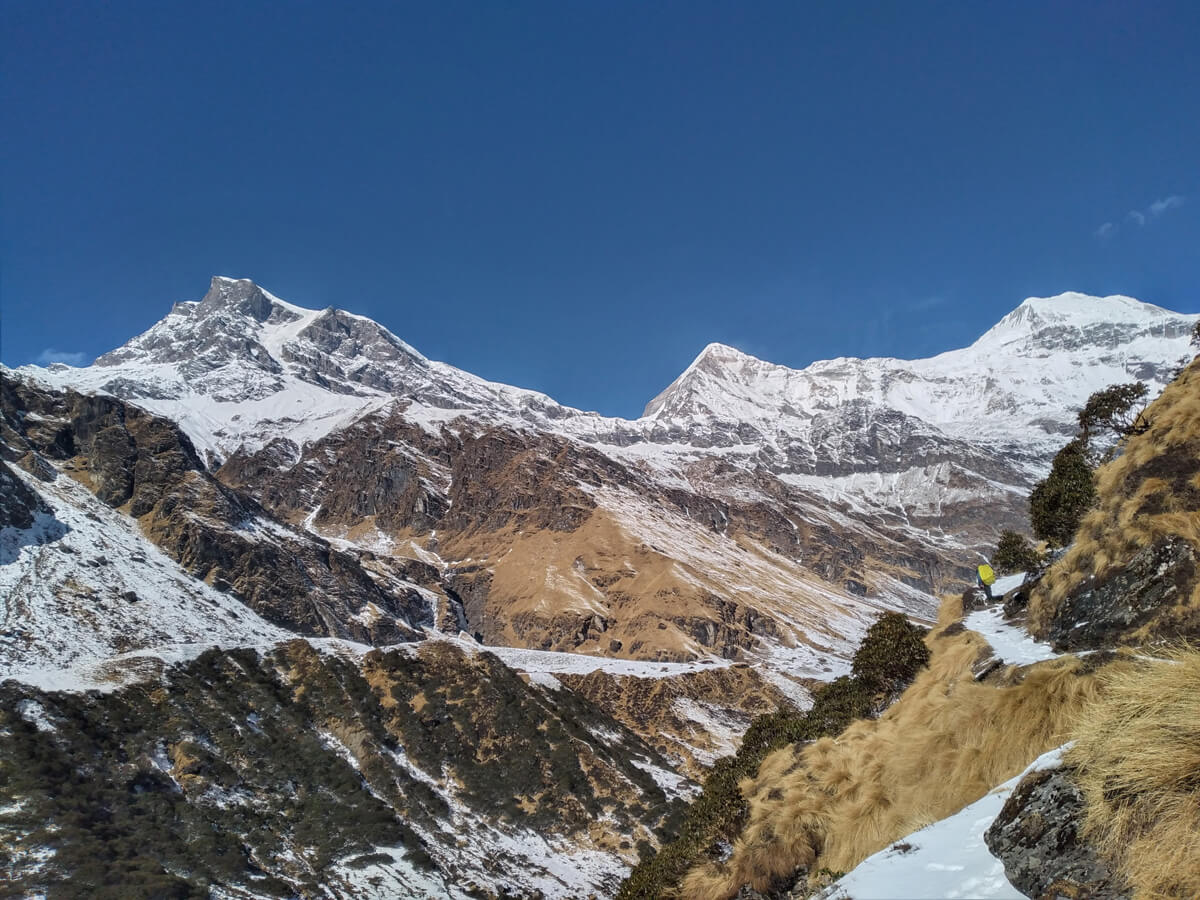
Peaks from left to right: Baljuri 5922m, Panwali Dwar 6663m and Nandakhat 6611m
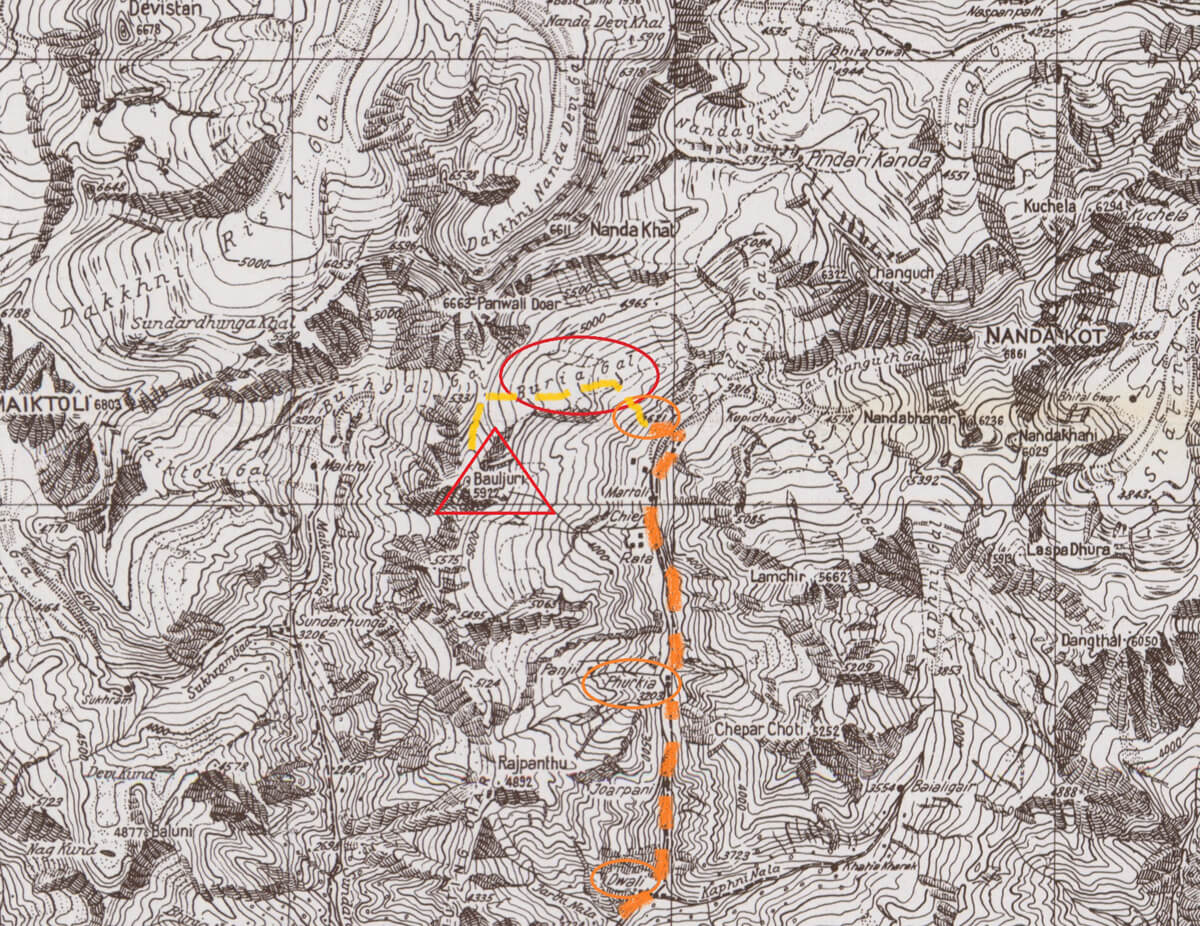
Topographic map ( Swiss contour, 1:150000) showing Baljuri and our proposed route
Acknowledgement of support
The expedition members are grateful to The Indian Mountaineering Foundation, Brig. Ashok Abbey (Hon.President- IMF), Dr. Kallol Das (Hon. Vice President- The Himalayan Club), Dr. Rupak Bhattacharya, Sri Gautam Dutta, Sri Bhushan Poshe, Allied Safety Sports, Sri Rohit Bhat, Dream Wanderlust, Sri Sujoy Dey, Sri Bapi Ray, Sri Karn Kowshik, Sri Vinod Singh, Sri Panigrahi and Trek Kit India for their kind patronage, guidance, camaraderie and support. A special mention of thanks must go to Sri Nilanjan Patra for a meticulous summary of meteorological forecast.
Background
“The only good reason to climb is to improve yourself”, said Yvon Chouinard. “Better we raise our skill than lower the climb”, said Royal Robbins. Bearing the simple yet profound messages of these legendary climbers in mind, a few of us decided to test ourselves on an alpine style, self supported climb on a Himalayan mountain in the middle of winter. To maintain the purity of our climb, we decided that we will not hire any high altitude porters or any local guide above base camp. Our team comprised of four members and just one low altitude porter. While one member in this team had done quite a few winter ascents in alpine style in his career, the rest of the team were being introduced to this style and season for the very first time.
Objective
We chose Mt. Baljuri (5922m) as our objective as for the following reasons:
- Ease of access. The base camp of Baljuri can be reached within 3 days’ hike and there is a well established trail up to the Pindari glacier Zero Point. While the three days of hiking will contribute to the team’s acclimatization process, we realized this (existence of trail up to BC itself) would be an advantage considering the winter snowfall pattern all over Uttarakhand and Himachal Pradesh in December 2020.
- Comparative non-technicality of the climb. We realized, for a team such as ours, treading the snows from deep down the valley floor will be a decent challenge in itself. Choosing an objective that demands additional artificial gear placement would be raising the bar a bit too high. We wanted to take one step at a time while improving skill as a team.
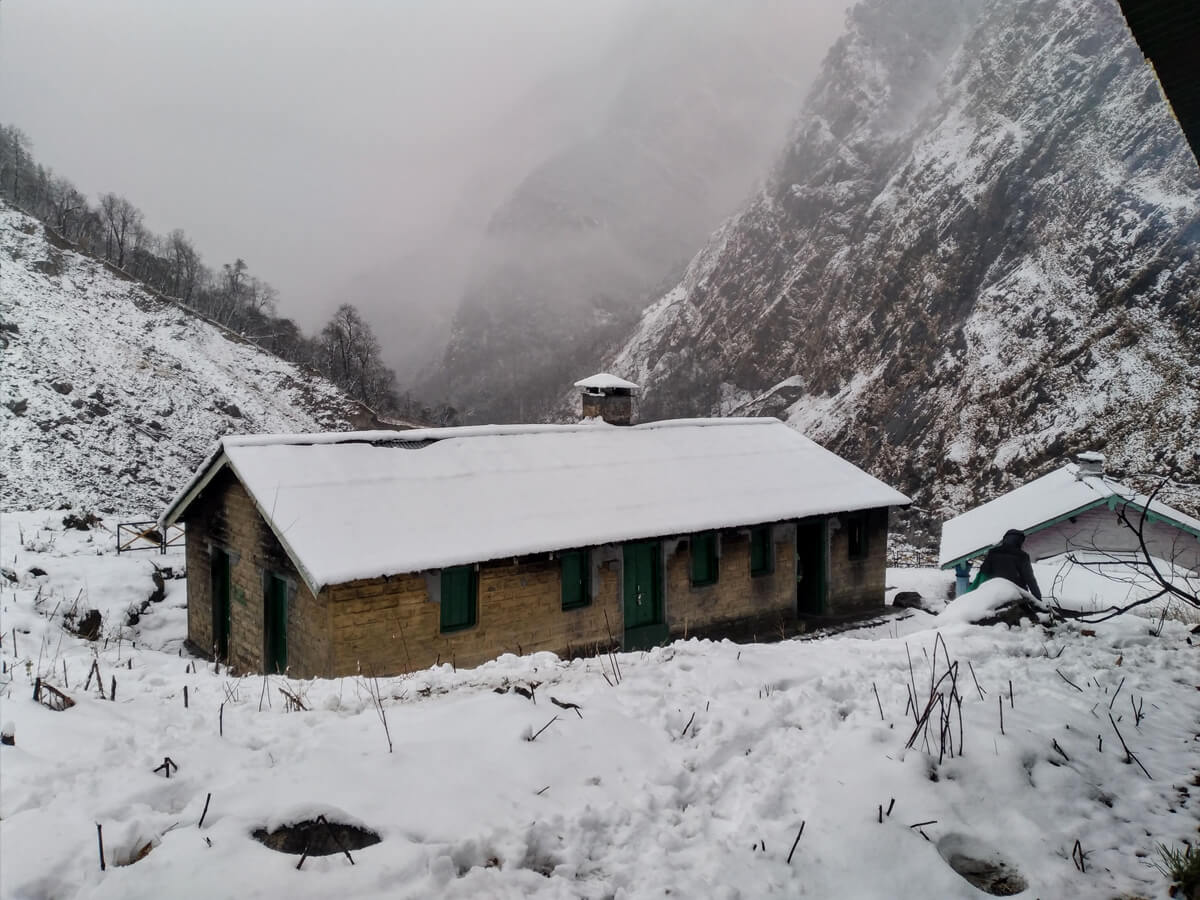
Dwali 2610m, 12th December, 2020
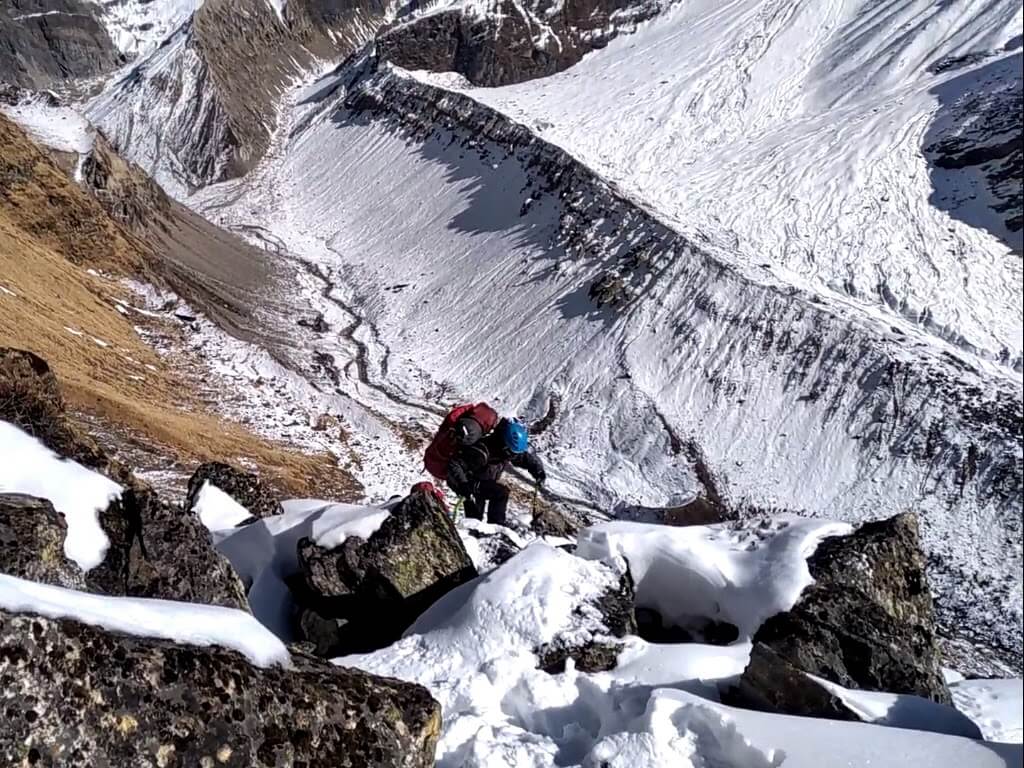
On the Spur looking down towards to the moraine ridges of Pindari glacier, 17 December
Itinerary
7th Dec - Board train at Howrah
8th Dec - Delhi
9th Dec - Work at the IMF and board overnight bus to Haldwani
10th Dec - Reach Haldwani in the morning, drive to Kapkote. Overnight Kapkote
11th Dec - Drive to Kharakiya, hike to Khati village, Stay at Khati
12th Dec - Khati to Dwali (2610m)
13th Dec - Load ferry to Phurkiya (3189m), stay at Khati
14th Dec - Shift to Phurkiya
15th Dec - Load ferry to base camp site, stay at Phurkiya
16th Dec - Shift to Base Camp (3600m)
17th Dec - Camp I-4160m
18th Dec - Camp-II (Bivi) - 4600m
19th Dec - return to base
20th Dec - Dwali
21st Dec - hike to road head
22nd Dec - drive to Haldwani, overnight bus to Delhi
23rd Dec - reporting at IMF, board train
24th Dec - reach Kolkata. End of expedition.
Description
On 11th December the team had reached the village of Khati via Kapkote and managed to hire two ponies upto Dwali and engaged one porter (Jai Singh Danu) who agreed to go as far as the traditional Basecamp of Baljuri. As none of the 4 climbers had ever been to the Pindar valley before, and as all the trails on the true right of the upper Pindar valley were hidden under snow, the solitary purpose of hiring just one porter was to locate the right starting point for the climb from the valley floor and to obtain a general direction of the route to the Buria glacier.
However, as the winter snowline had reached well below Dwali, it became their Basecamp. They reached Dwali on 12th December and as all huts were closed for the season, they camped inside the rest shed above the PWD rest house. On 13th, they ferried their loads to phurkiya and on 14th the whole team shifted there. The next day they made one more ferry to the traditional Basecamp site of Baljuri and shifted there on the 16th of December. Beyond Dwali and half way up to the zero point the team found the trekking trail under 6 inch to 1 feet of snow, but in treadable conditions.
On 17th 3 climbers ( Aniket, Rivusoumya and Anindya) started climbing the spur that leads one to the traditional camp 1 site of Baljuri. Ashish was forced to stay back as he had developed an acute tendon injury in his right leg on the previous day. By now the spur was a mixture of frozen grass, mud and boulders under a thick and deceptive (and sometimes treacherous) blanket of soft new snow. The trio reached the traditional camp 1 area after 6 hours of climb and spent the night there. The camp 1 site (4160m) itself was comparatively free of snow as it faces east and gets a lot of early morning sun.
On 18th December, the three started pushing higher. Very soon they found themselves in knee- deep to waist deep snow on a gradient that ranged between 35 to 45 degrees. The going became increasingly slow as a result and finally after 5 hours of trail breaking, step making, plodding, pushing and almost frustrating route finding through unconsolidated powder filled gully systems the three could climb only 500 meters. In the hope that early morning morning hours would offer better snow conditions the trio decided to call it a day and cut ( rather dug) a ledge on the north eastern face of point 4800mt located approximately 800mts south east of the Baljuri col and made a Bivi there. The altitude of this Bivi was approximately 4600mts.
On 19th December, as the three started climbing further up, to their surprise they found no change or improvement in snow conditions as hoped due to overnight freezing. As the team was getting very close (100m) to reaching a comparatively easier angled Neve of the Buria glacier, the team had encountered slab formations big enough to sweep them clear off the face. It is then the team decided to turn back immediately. The team cleaned the Bivi site and started a long and slow descend to the valley floor. They reached the traditional Basecamp by 5pm and were greeted by Ashish and Jai. On 20th December, the whole team trekked down to Dwali and on the 21st to Sarni, a hamlet at the road head of Kharakiya.
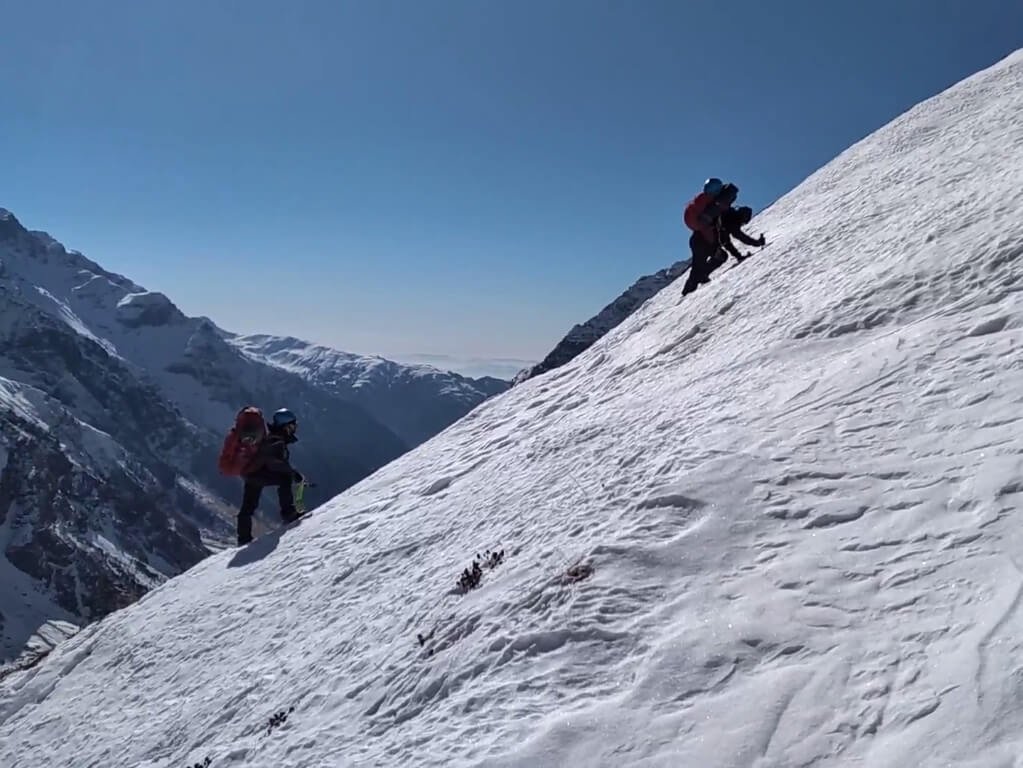
Between Camp 1 and Camp 2 (bivi), 18 December
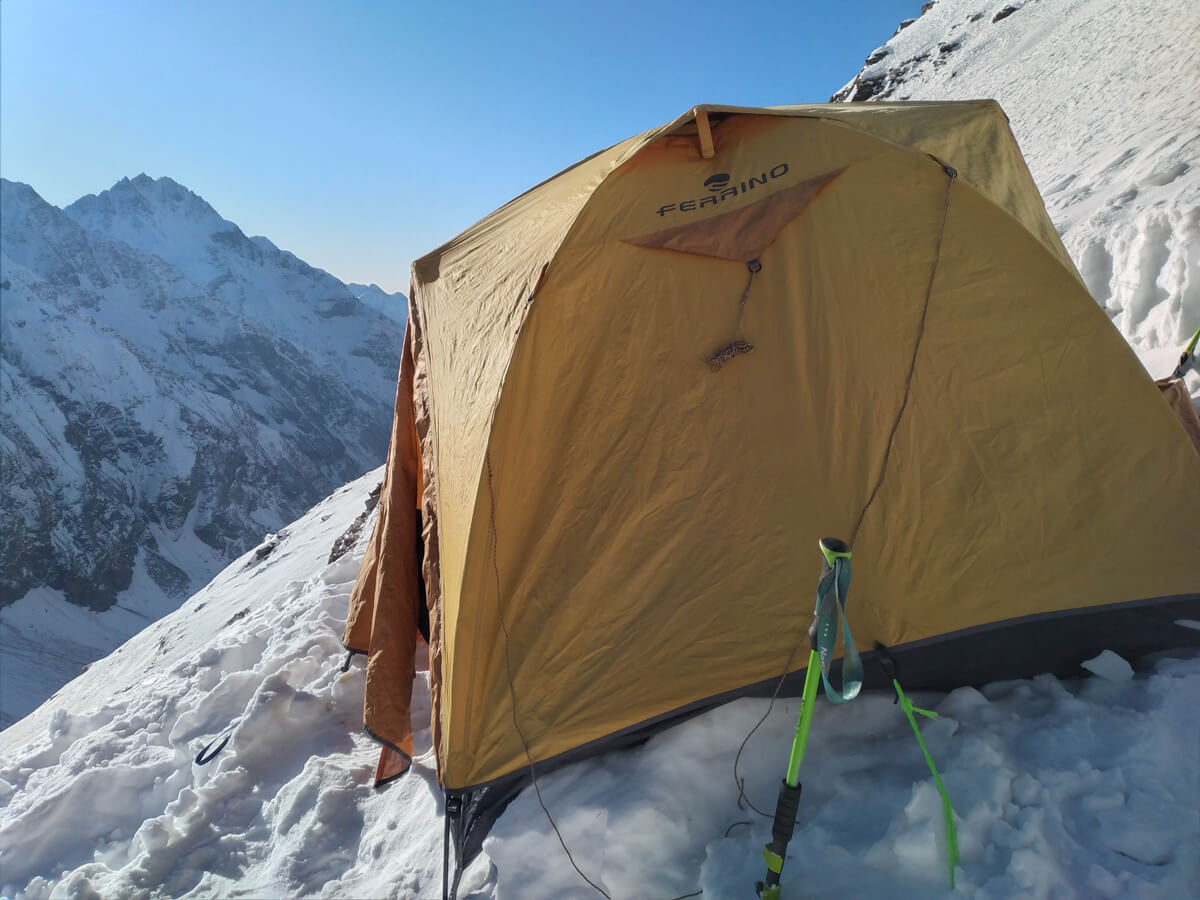
Our Bivi at 4600m
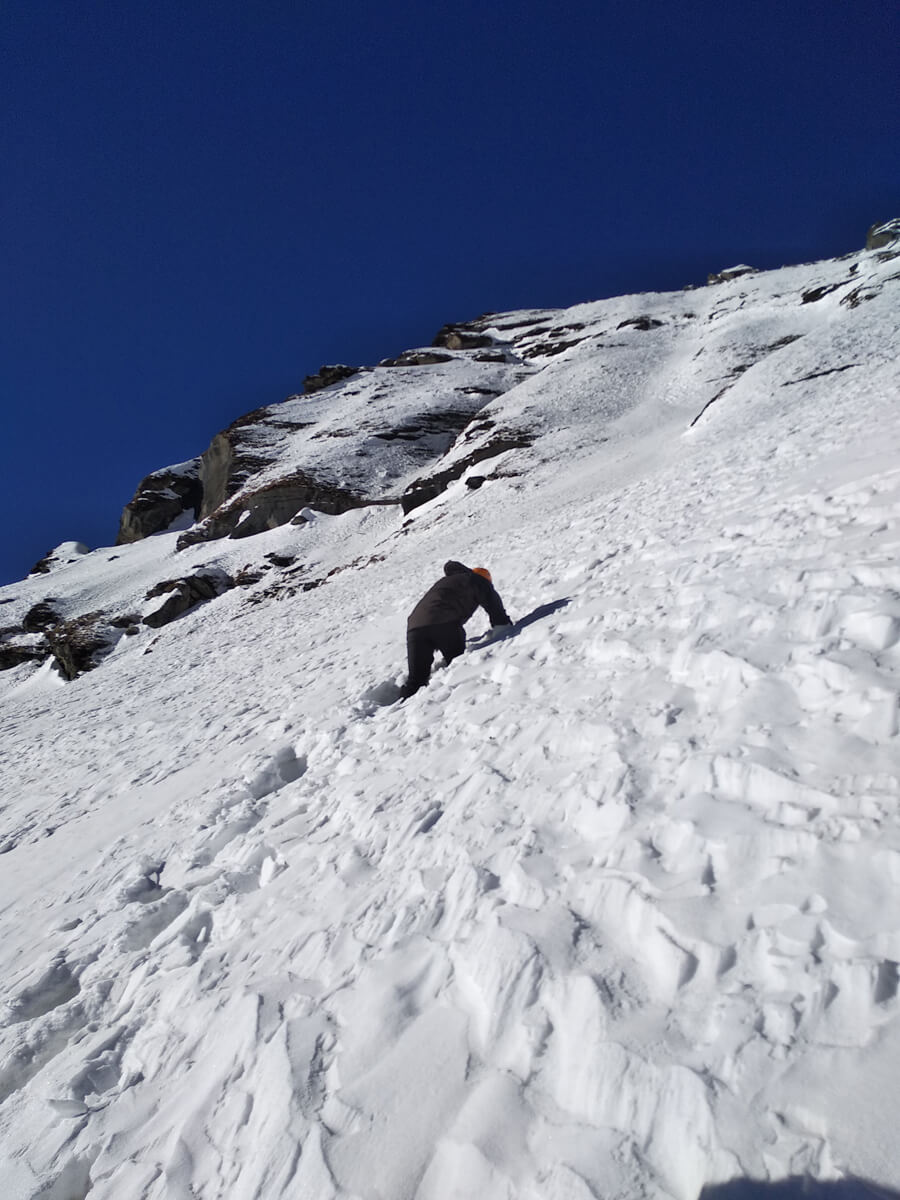
Inspection of snow conditions above bivi, 19 December
Style of Expedition
It was a lightweight, low impact on environment and low budget expedition in general. The team adopted alpine style climbing above base camp. Two mules were hired up to Dwali. Beyond Dwali (2610m) Jai Singh Danu of Khati village accompanied the team up to the base camp as a porter. Beyond the base camp, only three climbers moved up in a ‘carry-camp and climb’ style in a single push that lasted three days (17 December to 19 December). No fix ropes, no load ferries were done above base. The cumulative weight of food for five people for the entire duration of the trek and climb (4 members + 1 LAP) was below 20 kilos. A snapshot of what we carried as team ration is provided below:
- Oats - 4kgs
- Instant Noodles - 24 pkts - 1.5kgs
- Sattu - 2kgs
- Gur - 1.5kgs
- Sugar - 500gms
- Poha - 500gms
- Instant soup packets - 20 packets - 1kg
- Assorted tea bags and coffee - 250gm
- Horlicks - 750gms
- Egg white powder - 300gms
- Ready to eat meals - 250gmX15 pkts - 3.5kgs
- Snicker Bars - 45gmsX35 pc + 22gmX24 pc = 2kgs
- Dry fruits mix - 300gmsX4pkts = 1.2kgs
Expenditure outline
The total expenditure of the expedition was Rs. 1,02,851/ (Rupees One lakh two thousand eight hundred fifty one only). This included all the travel and permit costs. Individual contributions and kind donations of our well wishers made this expedition possible. A detailed expense statement is attached as an excel sheet along with this report. An outline of expense is provided below:
- Travel - 40801/
- Permits - 3000/
- Gear Rental from IMF - 9200/
- Mule+Porter - 26000/
- Food+lodging - 21676/
- Misc. - 2174/
- Total - 102851/
Grade of climb: Grade - III considering winter conditions and altitude.
Team: Aniket Mitra, Rivusoumya Das, Ashish Chanda, Jai Singh Danu, Anindya Mukherjee
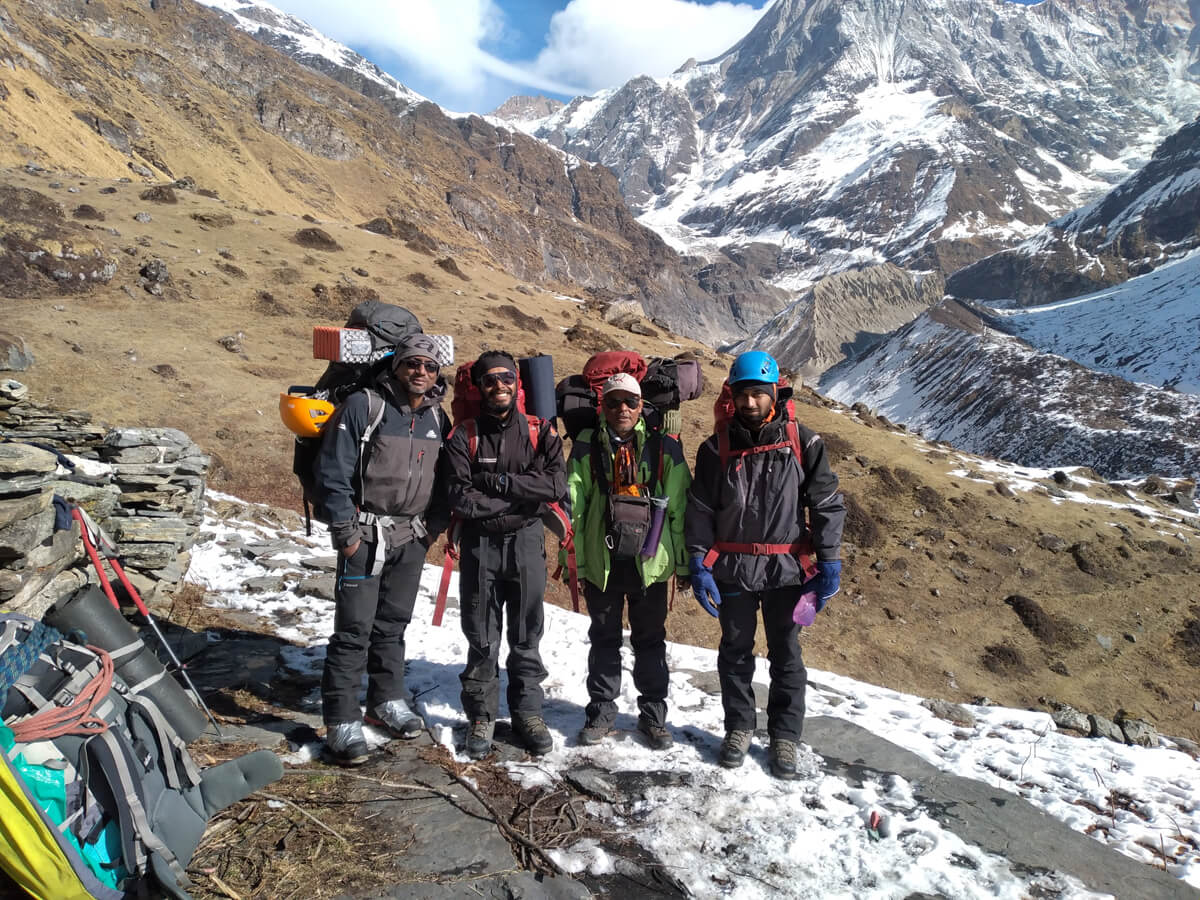
Team at BC after the attempt, 20th December, 2020
Related Articles
Place your ad here. Call +919163231788 or Contact Us










